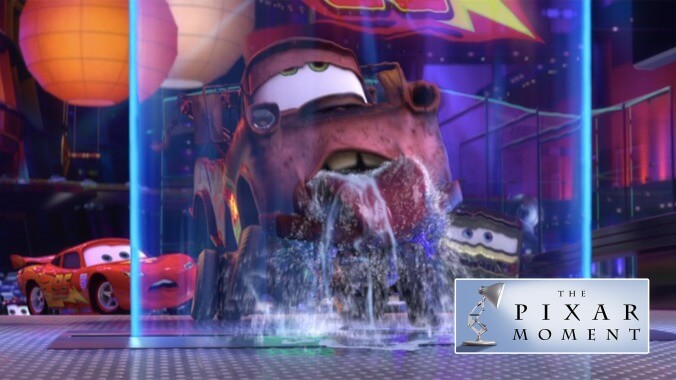Pixar’s hot streak screeched to a halt with a starring vehicle for Larry The Cable Guy

Nine years later, Cars 2 is still widely considered to be the worst feature film to roll off the Pixar assembly line. That, of course, is a matter of opinion, however close to consensus it may be. (For this critic’s money, the real lemon is the third film in the franchise—a jalopy of sputtering sports-movie clichés.) What seems indisputable is that John Lasseter’s second trip to a world of sentient automobiles brought the studio’s hot streak to a close. The original Cars had its detractors, but it was more of a creative pit stop, positioned between early triumphs and a run of acclaimed, ambitious movies that followed. With Cars 2, Pixar experienced its first crash and burn, critically if not commercially. And more than just proving that the studio wasn’t infallible after all, it essentially announced that the golden age of Pixar was over. A new era of prequels, sequels, and (mostly) lesser originals had begun.
The biggest sin Cars 2 commits is building its story almost entirely around Mater, the rusty tow truck voiced by Larry The Cable Guy. If the original Cars was an automotive gloss on the Michael J. Fox vehicle Doc Hollywood, the sequel essentially puts a new coat of paint on a different ’90s comedy, The Man Who Knew Too Little, with buck-toothed (buck-grilled?) sidekick Mater in the Bill Murray role of a clueless American who blunders unwittingly into espionage. (The spy-movie angle does allow for the film’s brightest spot: an opening action set piece involving a Bondian secret-agent car infiltrating an oil rig.) Regardless of what one thinks of Mater’s shtick, he’s a fairly one-note character, built mostly for comic relief. There’s a reason Toy Story 2 didn’t cede protagonist duties to Mr. Potato Head.
The creative team, to its credit, does seem aware that Mater’s charms are acquired at best. The plot, after all, hinges on race car Lightning McQueen’s reluctance to invite his hayseed buddy to accompany him overseas for a globetrotting grand prix. Lightning’s fears are confirmed at a swanky pre-race soirée in Tokyo, where Mater’s uncouth behavior makes him stick out like, well, a tow truck parked alongside a fleet of luxury sports cars. This is the scene where the spy plot intersects with the world-tour plot, but before being mistaken for an international truck of mystery, Mater makes a fool of himself, confusing wasabi for pistachio ice cream and leaking oil all over the stage.
Pixar has a gift for casting, and for catering material to performance (or vice versa); over the years, they’ve put Billy Crystal’s motor-mouthed exuberance, Albert Brooks’ neurotic wit, and Amy Poehler’s type-A cheeriness to brilliant family-friendly use. The comedian born Daniel Lawrence Whitney was the perfect choice to voice Mater, who’s just a gentler, four-wheeled version of his usual blue-collar stage persona. But where the best Pixar projects craft ideal comic vehicles for their voice actors, Cars 2 stoops to accommodate the lowbrow sensibilities of its suddenly top-billed star, who not only gets to spout signature catchphrases but also pratfall through some literal bathroom humor. That Mater is both the butt of the joke (he’s a dumb American, loudly baffled by an unfamiliar culture) and a sympathetic figure being gawked at by snobs reflects the contradictions of Larry The Cable Guy, a comedian who stereotypes some of the demographic he’s attempting to reach. His particular comic style ironically clashes with the technical sophistication on display; Cars 2 is as visually striking as any Pixar project, but also about as close as the studio has come, before or since, to pandering to the lowest common denominator.
That party scene becomes a microcosm for the movie containing it: Like Mater, Cars 2 pisses all over the floor, embarrassing everyone. Speaking of which, is he literally peeing when he spills oil ? That’s one of the many questions raised by this dubious franchise and “the world of (and above) Cars.” If there’s pistachio ice cream, where does the milk come from? Didn’t the first film establish that all livestock are just tractors? Do the cars need to eat, or do they just like to? How does their digestive system work? You could probably run Toy Story through a similar interrogation. But those films have good characters, exciting plots, thematic resonance—really, tons of aspects to focus on instead of the internal logic of their premises. With Cars, all you can do is admire the digital auto-body work, and wonder whether Mater has kidneys.